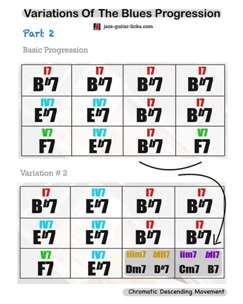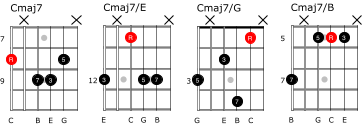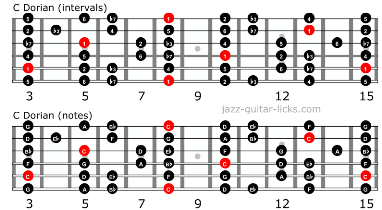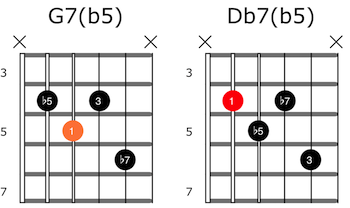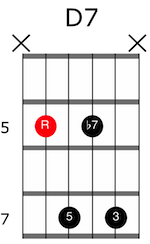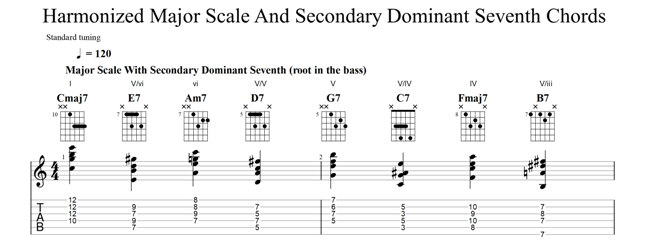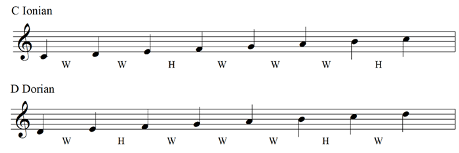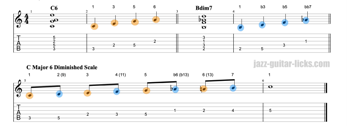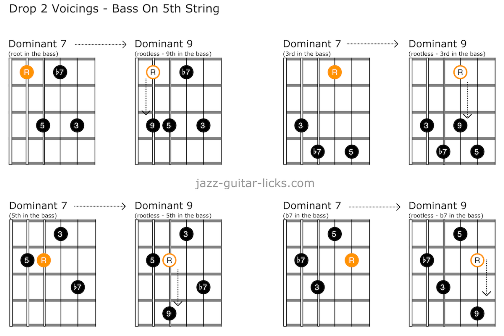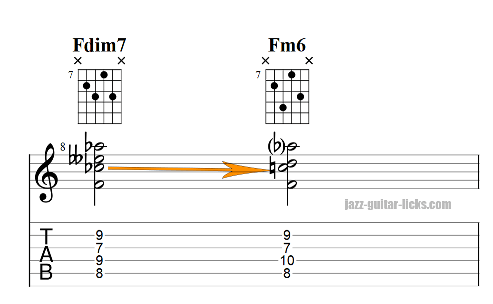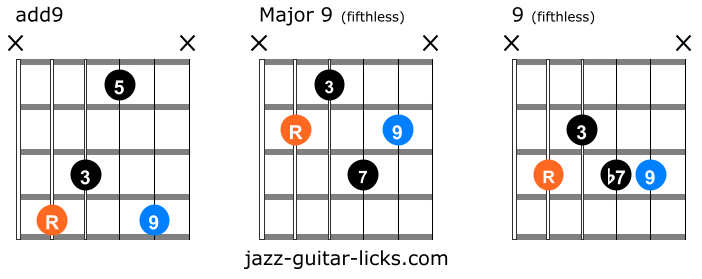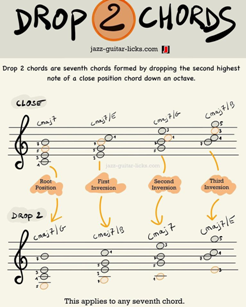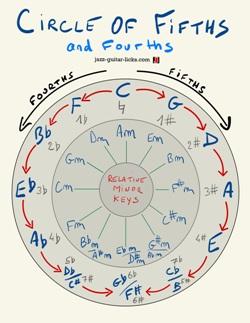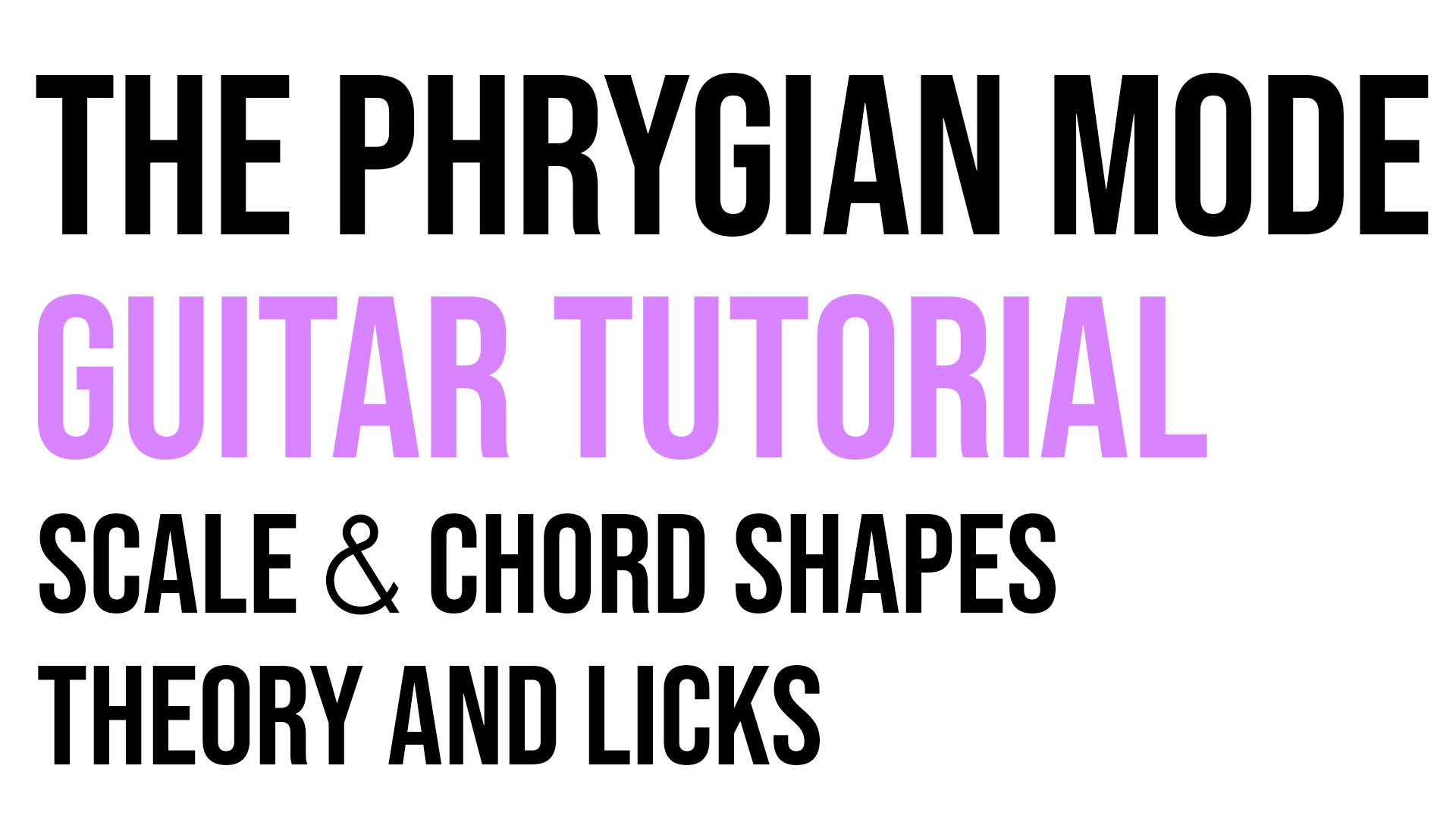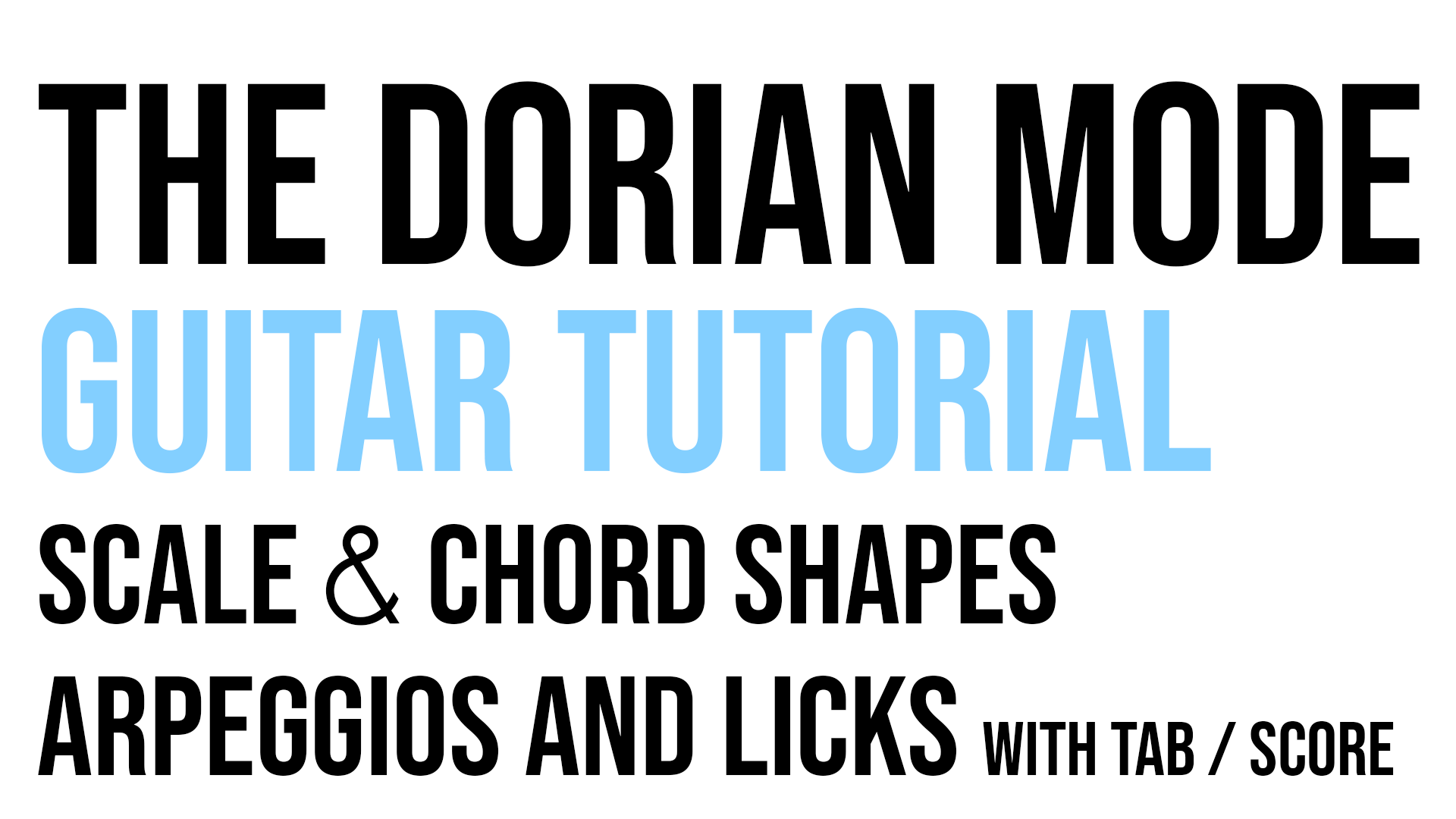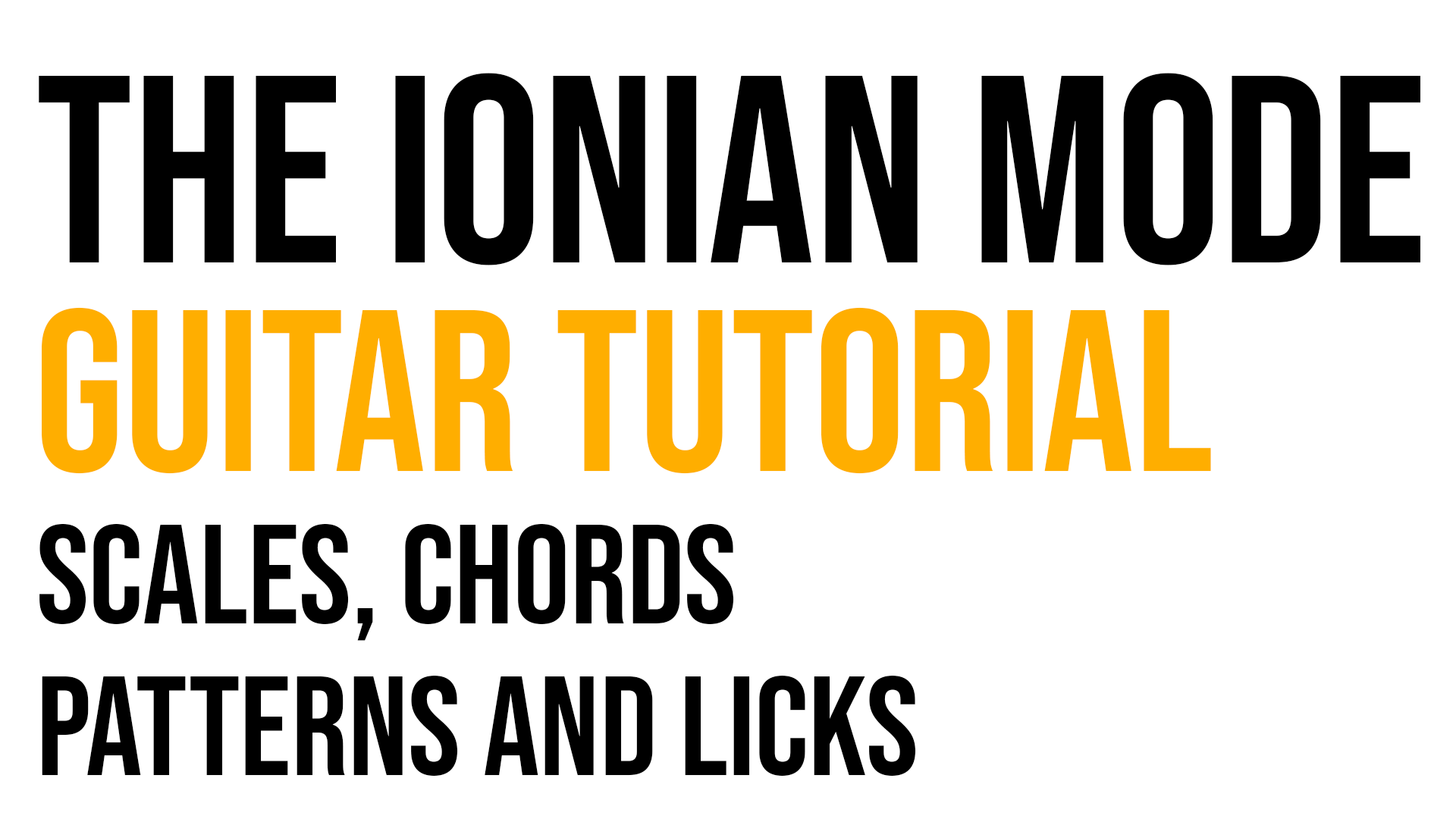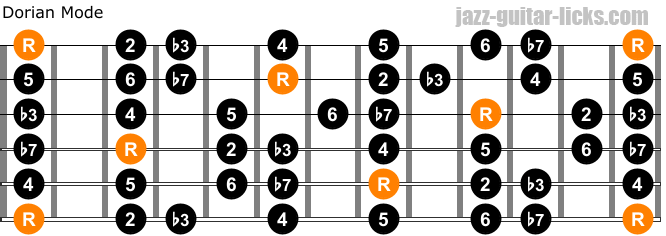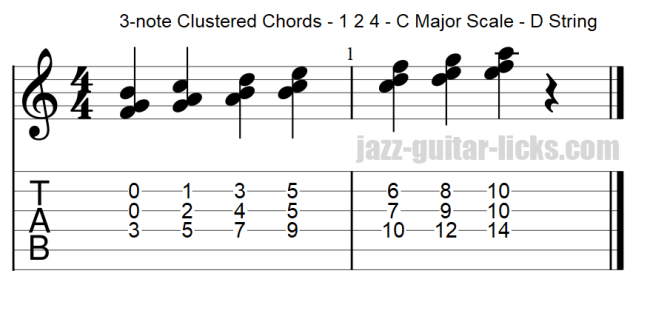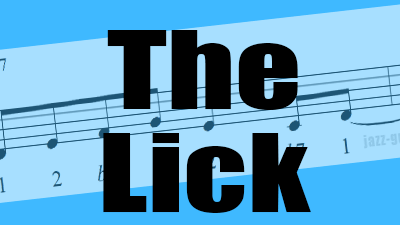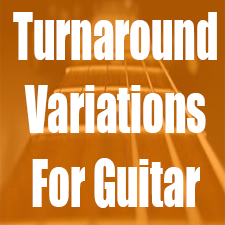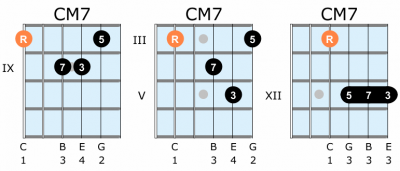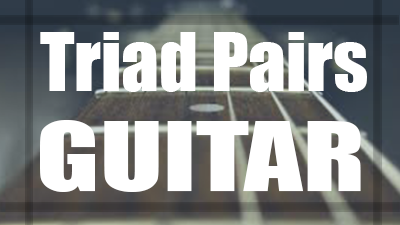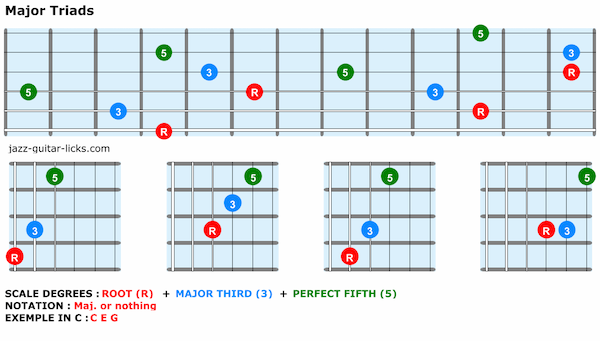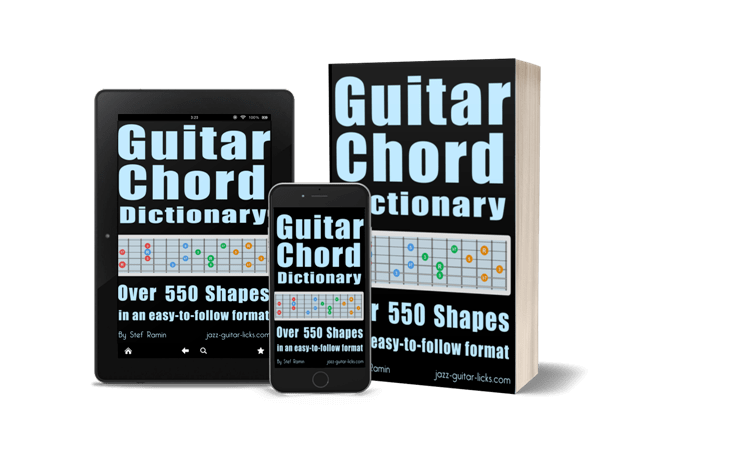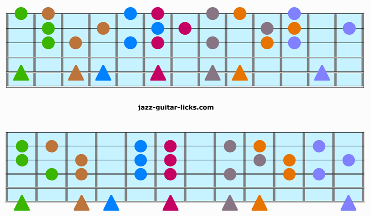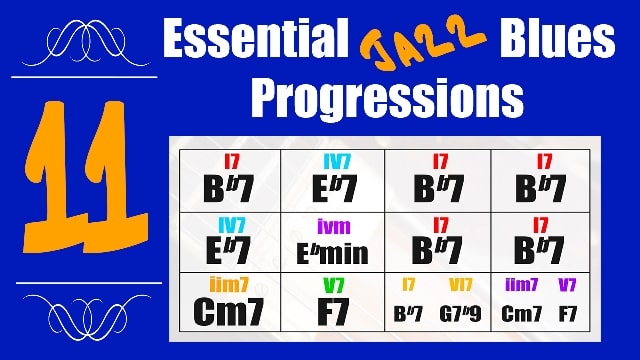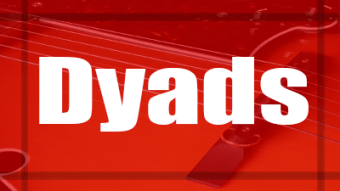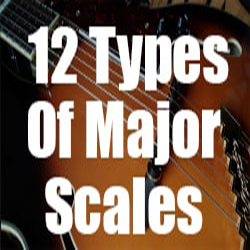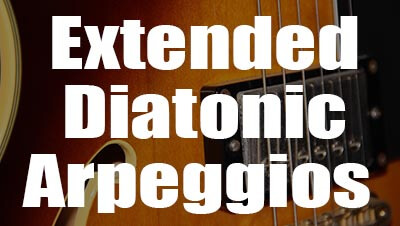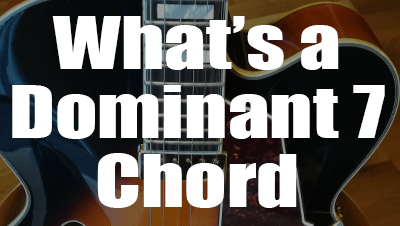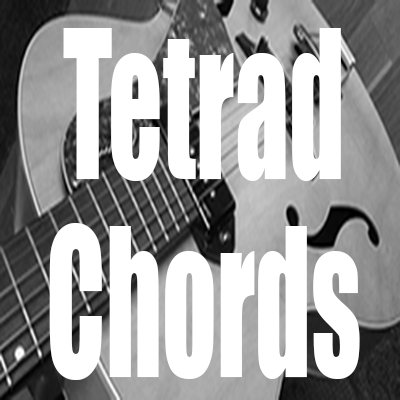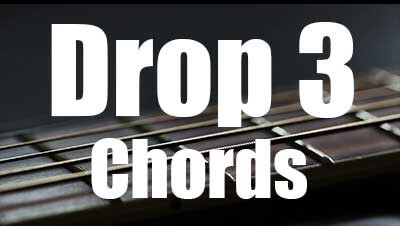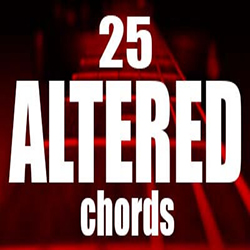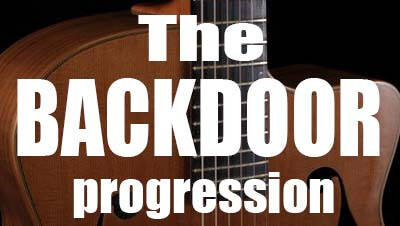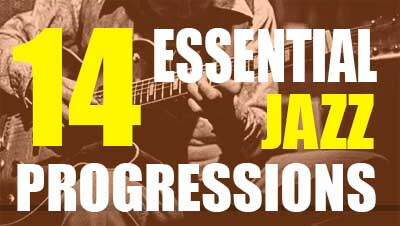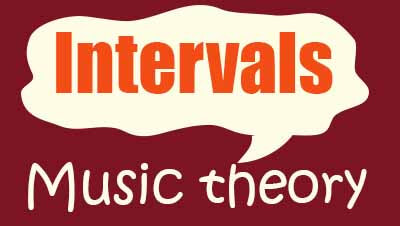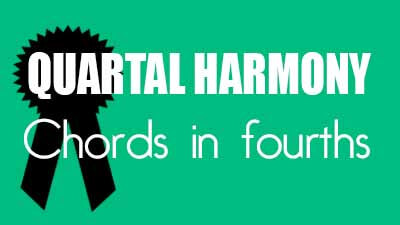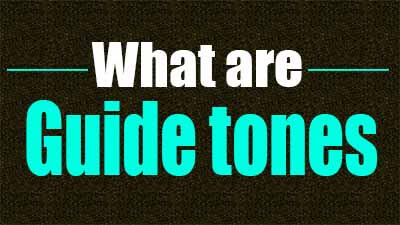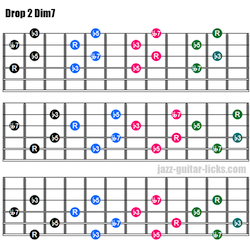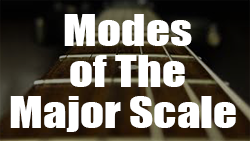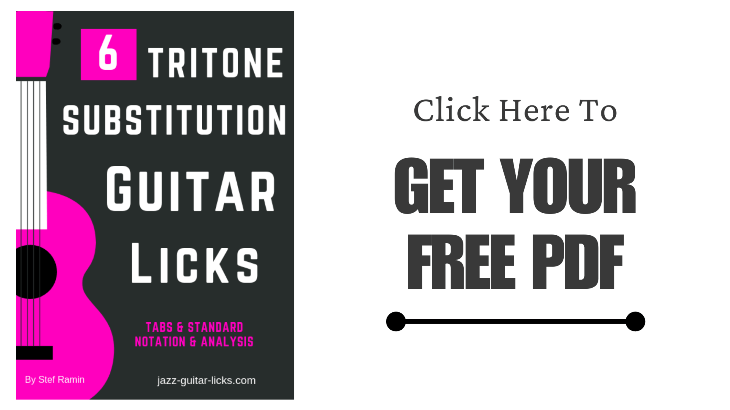Music Theory
Here, we simplify the building blocks of music—scales, chords, rhythms, and more—into easy-to-understand articles.
-
Chromatic Descending Chord Sequence Over A Basic Blues Progression
- By jazz-guitar-licks
- On 2024-06-25
- In Chords / Voicings
- 0 comments
This guitar lesson for beginners explains what's a basic blues progression and how to add a chromatic descending chord sequence at the end.
-
Slash Chords On Guitar - Lesson With Charts And Diagrams
- By jazz-guitar-licks
- On 2024-03-07
- In Jazz Guitar Lessons
- 0 comments
Slash chords, distinguished by a chord followed by a forward slash and a bass note (e.g., C/G), are a powerful tool for enriching your guitar sound.
This guitar lesson for beginners unravels the mystery behind slash chords, revealing how they redefine familiar shapes and add a touch of sophistication to your chord progressions.
-
How To Use Diminished 7 Chords On Guitar - 4 Examples
- By jazz-guitar-licks
- On 2024-01-17
- In Chords / Voicings
- 0 comments
Diminished 7 chords bring a distinctive, mysterious sound to music.
Widely used in jazz and classical genres, they infuse tension and creativity into your playing.
This guitar lesson explains how they are built and how to use them thanks to four easy examples.
-
9 Essential Guitar Scales For Beginners
- By jazz-guitar-licks
- On 2024-01-01
- In Jazz Guitar Lessons
- 0 comments
Jazz music, known for its improvisational nature and rich harmonic complexities, is a genre that heavily relies on scales for melodic expression and harmonic exploration. Understanding essential scales is a crucial step in comprehending its harmonic structure and developing improvisational skills.
Here's an overview of nine fundamental jazz scales ideal for beginners:
-
Chord Substitution - Enharmonic Equivalents - Altered & Extended Dominant Seventh Chords
- By jazz-guitar-licks
- On 2023-12-19
- 0 comments
This guitar theory lesson about harmonic equivalents provides six examples, that demonstrate how dominant seventh chords (rootless, altered or extended) can also be considered as other types of chords (min6, dim7, 7).
-
How To Identify Chords By Ear - Advices And Practice Tips For Guitar Players
- By jazz-guitar-licks
- On 2023-09-09
- In Guitar Practice Tips
- 0 comments
Identifying chords by ear is a valuable skill for any musician, especially in jazz. Here's a step-by-step guide to help you develop your ability to identify chords by ear:
-
Major Scale And Secondary Dominant Seventh Chords - Free PDF Transcription And YouTube Short Videos
- By jazz-guitar-licks
- On 2023-08-17
- 2 comments
This guitar lesson implies playing secondary dominant seventh chords of the harmonized major scale.
Free PDF available on GUMROAD and four YouTube short videos at the bottom of this page.
-
Harmonization of Minor Scales On Guitar - Natural, Melodic and Harmonic Minor
- By jazz-guitar-licks
- On 2023-08-03
- 4 comments
Harmonization of minor scales involves creating chords by stacking thirds on each note of the scale.
There are three common types of minor scales: natural minor, melodic minor, and harmonic minor.
This guitar lesson explore each one and explain how to harmonize them on guitar.
-
Dominant, Subdominant, Secondary Subdominant and Secondary Dominant Chords - Guitar Theory Lesson
- By jazz-guitar-licks
- On 2023-07-30
- 0 comments
In music theory, the terms "dominant," "subdominant," and "secondary dominant" are used to describe different types of chords and their functions within a key or harmonic progression.
Here's an explanation of each term with examples for guitar players.
-
Relative And Parallel Modes - Music Theory Lesson For Guitar
- By jazz-guitar-licks
- On 2023-05-19
- In Jazz Guitar Lessons
- 0 comments
In this theory lesson with diagrams and charts you will learn what's the difference between relative and parallel modes and how to play them on guitar.
-
The Major Sixth Diminished Scale - Jazz Guitar Lesson Around The Barry Harris Concept
- By jazz-guitar-licks
- On 2023-03-20
- In Jazz Guitar Lessons
- 2 comments
This guitar lesson is about a harmonic concept mapped out and developped by jazz musician Barry harris that can be found in the book "The Barry Harris Harmonic Method For Guitar" by Alan Kingstone.
This blog article details a little bit more in depth about what is the major 6 diminished scale and how to harmonize it with major 6 and diminished 7 chords.
FREE PDF AVAILABLE HERE ON THE GUMROAD STORE
-
How To Turn A 7th Chord Into A Rootless 9th Chord - Theory Lesson For Guitarists
- By jazz-guitar-licks
- On 2023-02-15
- 2 comments
This chord theory lesson focuses on how to transform a dominant 7 chord (drop 2, drop 3 and related inversions) into a rootless ninth chord by replacing the tonic (1) with the ninth (9).
This technique will help guitarists expand their harmonic knowledge and also explore their neck in more depth. This can be a useful trick when composing or for chord melody arrangements.
-
Diminished 7 Chords - Connections With Dominant 7 And Minor 6
- By jazz-guitar-licks
- On 2022-12-11
- 0 comments
In this guitar lesson you will learn how to transform a diminished 7 chord into a dominant 7 and also a minor 6 chord either by lowering or raising only one note in order to get a smooth transition.
Check the GUMROAD shop to get the free PDF.
-
Differences Between Maj9, add9 and 9 Chords - Music Theory For Guitar With Charts And Neck Diagrams
- By jazz-guitar-licks
- On 2022-11-16
- 0 comments
This guitar lesson with charts and shapes will help you understanding the differences between major 9, add9 and dominant 9 Chords. How they are built and how to play them on guitar.
-
Chord Extensions - Music Theory Lesson
- By jazz-guitar-licks
- On 2022-06-07
- 0 comments
In this theory lesson we will see how to add natural and altered extensions to 7th chords. The aim being to bring new colors and so to embellish your chord progressions. This concept is a very important device for composing, chordal accompaniment and chord-melody arrangements.
-
Natural Minor Scale Harmonization - Guitar Theory Lesson
- By jazz-guitar-licks
- On 2022-04-13
- 2 comments
This guitar theory lesson covers a very important topic that any musician must know : How To Harmonize The Natural Minor Scale?
You will learn how to build triads and seventh chords starting on each note of the natural minor scale.
-
Difference Between Dominant 7 and Major 7 Chords - Music Theory For Guitar
- By jazz-guitar-licks
- On 2022-04-04
- In Chords / Voicings
- 0 comments
This theory lesson for guitarists covers one the most common question asked by beginner musicians : what's the difference between a dominant seventh and a major seventh chord.
-
How Drop 2 Chords Are Built - Music Theory Cheat Sheet
- By jazz-guitar-licks
- On 2021-08-29
- 0 comments
Drop 2 chords are built by dropping the second highest note of a close chord down an octave, thus giving four supplementary ways of playing a seventh chord (min7, maj7, dom7, m7b5, dim7, aug7, augMaj7).
This free music theory cheat sheet will help you understand how these drop 2 voicings are built. You can easily get it for free (or name a fair price) in PDF format on GUMROAD.
-
The Circle of Fifths - Music Theory
- By jazz-guitar-licks
- On 2021-07-22
- 0 comments
The circle of fifths is the way the 12 musical notes of the chromatic scale are arranged following a sequence of perfect fifths (7 semitones).
It helps visualizing relationships between notes and better understanding diatonic harmony.
-
The Phrygian Mode - Theory, Licks, Charts and Shapes
- By jazz-guitar-licks
- On 2021-01-07
- In Jazz Guitar Lessons
- 0 comments
You'll find in this blog post several cheat sheets for guitarists about the Phrygian mode, third mode of the major scale. These infographics are related to the YouTube video below. They show how this minor scale is built, how to play it on guitar, what are the related chords, how to use it over common chord progressions, etc.
-
Dorian Mode Tutorial - Theory, Shapes, Chords, Scales, Arpeggios & Licks
- By jazz-guitar-licks
- On 2020-12-07
- In Jazz Guitar Lessons
- 0 comments
This blog post contains free cheat sheets (infographics) for guitar players about the Dorian mode. You will find useful information on how to play chords, arpeggios and minor licks directly related to this minor scale.
-
Major Scale Aka Ionian Mode - YouTube Video - Cheat Sheets For Guitar - Scales, Chords, Patterns and Licks
- By jazz-guitar-licks
- On 2020-11-26
- In Jazz Guitar Lessons
- 0 comments
Here are some free cheat sheets for guitar teachers and students about the Ionian mode aka The Major Scale. Here, you'll find chord and scale shapes with easy patterns and licks related to the Ionian mode.
-
Essential Minor Scales For Guitar - 14 Types - Shapes and Theory
- By jazz-guitar-licks
- On 2020-10-13
- In Scales & Arpeggios
- 0 comments
This guitar lesson sheds light on the different types of minor modes and scales that can be used in jazz music.
They are built with different combinations of intervals starting on different steps of several scales as the major scale, the melodic minor, the harmonic minor, the harmonic major, the pentatonic scale and the bebop scale.
-
19 Essential Jazz Guitar Books - Buyer's Guide
- By jazz-guitar-licks
- On 2020-10-06
- In Music Reviews
- 2 comments
The world of jazz guitar books can be a daunting and overwhelming experience for the beginning guitarist. There are literally thousands of books on jazz guitar, many with similar content and information.
Some books are better suited to learning chords, while others are designed to enhance reading skills, still others are meant to teach improvisation concepts. Some books attempt to cover all of these bases. Some of the most useful are collections of transcribed solos and etudes.
Fortunately for you, I have been studying jazz guitar for 15 years and have practiced and taught from many of the best jazz guitar books available on the market.
Whether your focus is developing a strong sense of rhythm, building your improvisational skills, mastering a wide range of chord voicings, progressions, and substitutions, or understanding the theory that ties all of it together, you can use this list of the best jazz guitar books to help guide your path! -
28 Ways of Playing a Dominant 7 Chord On Guitar
- By jazz-guitar-licks
- On 2020-08-22
- In Chords / Voicings
- 0 comments
Dominant 7 chords are surely the most important to know when you want to try your hand at jazz guitar. These chords are very present in jazz and blues tunes, that's why it is crucial to know them at your fingertips.This quick lesson show 28 dominant 7 guitar shapes based on drop 2, drop 3 and drop 2-4 voicings.
-
Cluster Chords On Guitar - Theory And Exercises With Tabs
- By jazz-guitar-licks
- On 2020-08-19
- 2 comments
This guitar lesson with tabs and theory is about cluster chord voicings.
These are chords in which at least two notes are grouped together in order to create a sort of dissonance.
Cluster chords are sometimes quite difficult to play on guitar but they have a very interesting sound widely used in comtemporary jazz and neo-soul music.
-
"THE LICK" - The Most Iconic Jazz Lick - Guitar Lesson With Exercises
- By jazz-guitar-licks
- On 2020-08-04
- In Jazz Guitar Lessons
- 1 comments
"The Lick" is considered as the most famous phrase in jazz music (and also in other styles).
It has been played so many times, by so many players, in so many tunes that it has become a cliche.
Although there are a significant number of common jazz lines, this one is surely the most popular, an essential part of the Bebop language.
This guitar lesson with tabs, charts and theory explains what is "The Lick", how it is built and how to apply it in different harmonic contexts.
-
1 6 2 5 Turnaround Variations - Lesson With Guitar Tabs & Theory
- By jazz-guitar-licks
- On 2020-04-17
- In Jazz Guitar Lessons
- 2 comments
A turnaround is a section of two or four bars at the end of a tune.
Its role is to create a harmonic transition going back to the beginning.
It present in many jazz tunes and is an important part of "rhythm changes" progressions.
They is also used to create effective jazz intros and endings.
This lesson with guitar tabs contains 17 exercises for better understanding of the 1 6 2 5 turnaround and its variations.
-
Jazz Guitar Chords For Beginners - Complete Guide
- By jazz-guitar-licks
- On 2020-02-15
- 2 comments
Learning jazz guitar chords is a real challenge for beginners.
In this lesson, you will understand how they are built and how to play them on guitar.
-
Triad Pairs For Jazz Guitar - Theory, Tabs, Exercises
- By jazz-guitar-licks
- On 2020-02-02
- In Jazz Guitar Lessons
- 0 comments
The triad pair system is a technique used by many jazz improviser to build modern improvised lines.
It consists of playing two adjacent triads from a scale.
The most used are from the major diatonic system, however it is possible to use triad pairs from other scales as melodic minor, harmonic minor and harmonic major.
This guitar lesson with tabs, shapes and theory is focused on triad pairs from the major scale only.
-
Guitar Chord Construction - Theory And Basic Shapes - Essential Guide
- By jazz-guitar-licks
- On 2020-01-18
- In Jazz Guitar Lessons
- 6 comments
This lesson explains how jazz guitar chords are built and how to play them using common positions.
This will help you understand, identify, build and play one of the most important types of chords.
All the shapes proposed in this tutorial are movable and playable anywhere on the fretboard.
-
Intervals on Guitar - Shapes and Theory
- By jazz-guitar-licks
- On 2019-12-23
- In Jazz Guitar Lessons
- 0 comments
Whether simple or compound intervals are a very important part of music theory.
Knowing them allow understand how scales, arpeggios and chords are built.
Intervals are useful tools to visualize the notes and understand their relationships on the guitar fretboard.
This lesson with downloadable pdf, guitar shapes and theory will help you better figure them out and play them on guitar.
-
Harmonic Minor Scale Guitar Chords - Theory With Diagrams And Charts
- By jazz-guitar-licks
- On 2019-12-15
- 3 comments
This lesson explains how to build drop 2 and drop 3 seventh chords from the harmonic minor scale.
This action which consists in stacking notes in interval of thirds starting on each tone of a scale is commonly called "harmonization".
-
Blues Progressions For Jazz Musicians - 11 Forms With Analysis & Audio Files
- By jazz-guitar-licks
- On 2019-10-06
- 0 comments
Blues progressions are fairly present in jazz, there are many variations on the basic structure.
In this lesson you will learn to incorporate major, minor II V I sequences and turnarounds in order to make them evolve.
-
Diatonic Dyads For Guitar - Lesson With Shapes - Music Theory
- By jazz-guitar-licks
- On 2019-09-29
- In Jazz Guitar Lessons
- 0 comments
In music, a dyad refers to a two-note chord or interval. Unlike traditional chords, which consist of three or more notes played simultaneously, dyads are comprised of only two notes. This guitar lesson explores the concept of diatonic dyads.
-
36 Ways of Playing a Dominant 7 Chord on Guitar
- By jazz-guitar-licks
- On 2019-07-30
- 0 comments
Dominant 7 chords are one of the most important chords to know, they can be found in many styles of music as blues, funk, pop and of course in jazz music. In this lesson we will see how dominant 7 chords are built and how to play them on guitar using 36 different voicing shapes.
-
Harmonization of the Melodic Minor Scale - Chord Shapes and Theory
- By jazz-guitar-licks
- On 2019-07-26
- 2 comments
In this lesson we will see how to harmonize the melodic minor scale in thirds with seventh chords.
In other words we will see how to build seventh chords by stacking thirds from each degree of the melodic minor scale.
-
What Scale to Play Over 7b9 Chord
- By jazz-guitar-licks
- On 2019-07-12
- In Scales & Arpeggios
- 0 comments
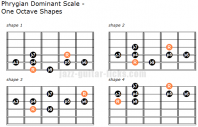 Dominant 7 flat ninth chords (7b9) are generally related to the fifth mode of the harmonic minor scale known as Phrygian dominant scale, which makes it the most obvious choice for improvising over 7b9 chords. However, we will see in this article that there are many other options.
Dominant 7 flat ninth chords (7b9) are generally related to the fifth mode of the harmonic minor scale known as Phrygian dominant scale, which makes it the most obvious choice for improvising over 7b9 chords. However, we will see in this article that there are many other options. -
12 Types of Major Scales - Guitar Lesson With Diagrams
- By jazz-guitar-licks
- On 2019-04-16
- 2 comments
When we think about major scales, the first that comes to mind is the Ionian mode, best know as THE major scale. However, there are several other types of major scales (Ionian #5, Lydian augmented #2, Ionian b6) which deserve a little more attention. Here they are listed with guitar shapes and formulas.
-
II V7 Bebop Patterns - David Baker - Analysis and Scale Diagrams
- By jazz-guitar-licks
- On 2019-03-21
- In Jazz Guitar Lessons
- 0 comments
This blog article is related to the video tutorial published on JGL YouTube channel. It contains 10 II V7 jazz bebop guitar patterns with analysis and scale shapes.
These lines come from the first chapter of David Baker's book "How To Play Bebop Vol.2 - Learning the bebop language". They correspond to the first ten exercises of the section named "The Use of The II V7 Progression in Bebop".
You 'll find in this lesson a quick analysis of each pattern with scale diagrams (Dorian, Dorian bebop, Mixolydian, dominant bebop, Mixolydian b13, altered, mixo-blues and half-whole diminished).
-
Solar - Miles Davis - Guitar Chord Melody Lesson and Analysis With Tabs
- By jazz-guitar-licks
- On 2019-03-04
- In Jazz Guitar Lessons
- 0 comments
"Solar" is a jazz standard written by Miles Davis in the key of C minor with four tonal centers that are : C minor, F major, Eb major and Db major. Solar contains essential chord progressions as major and minor II V I. This lesson provides a short harmonic analysis and a chord melody arrangement for guitar with tabs, standard notation, chord shapes and audio file.
-
How to Use a Tritone Substitution - 6 Guitar Licks
- By jazz-guitar-licks
- On 2019-02-08
- In Licks & Transcriptions
- 0 comments
 What's a Tritone Substitution?
What's a Tritone Substitution?The tritone substitution is one of the most common substitution found in jazz. The basic application of a tritone chord substitution is to take any 7th chord and play another 7th chord that has its root a tritone away from the original. This guitar lesson demonstrates how you can play scales and arpeggios starting from the b5 (a tritone away) of the V7 chord in a II V I chord progression. This way you will highlight altered tones as the b9 and the #11.
-
Extended Arpeggios For Guitar - Upper-Structure of Chords and Superimposition
- By jazz-guitar-licks
- On 2018-11-23
- In Scales & Arpeggios
- 0 comments
When learning how to play jazz guitar, one of the most important device to master is to play each tone of a chord in order to outline a specific progression.
This is what we call arpeggios.
They are great melodic tools when you want to highlight the chords you are soloing over.
This lesson is focused on diatonic seventh arpeggios and their extensions.
-
Three Types Of Minor Blues Scales
- By jazz-guitar-licks
- On 2018-10-23
- In Scales & Arpeggios
- 0 comments
In this lesson you will learn how to build, play and recognize each of the three types of minor blues scales.
-
Triads On Guitar - Lesson With Tabs & Shapes
- By jazz-guitar-licks
- On 2018-10-08
- 8 comments
Triads are one of the first harmonic tools to study. They are very useful for comping and chordal enrichment.
Learning close and open (aka spread) triads increase your harmonic knowledge and at the same time help you discover your fretboard.
In this lesson you will see the main triad chord shapes including root positions and inversions.
You will also find some ideas on how to use triads over a II V I sequence, in order to create interesting melodic movement in your comping.
-
What Are Dominant Seventh Chords ?
- By jazz-guitar-licks
- On 2018-09-29
- 0 comments
Dominant seventh chords are the most important features in music, you can find them in many styles of music, especially in blues and, of course, in jazz. In this lesson, you will see how to construct drop 2, drop 3 and drop 2 & 4 dominant seventh chords, what is their harmonic function and how to play them on guitar.
-
Drop 2 & 4 Chords - Advanced Guitar Voicings
- By jazz-guitar-licks
- On 2018-09-14
- 0 comments
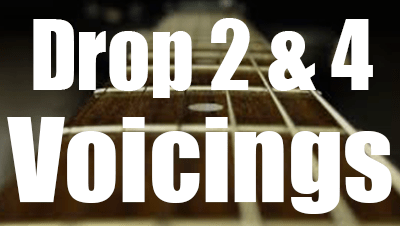 What Are Drop 2-4 Chords?
What Are Drop 2-4 Chords?Drop 2 and 4 chords are created by dropping down an octave the second and fourth note of a seventh chord in close position. They can be very important tools for composition and arrangement. This lesson with diagrams provides useful explanations on how to build and play drop 2 & 4 chords on guitar.
-
Tetrad Chords / Seventh Chords - Music Theory with Guitar Shapes
- By jazz-guitar-licks
- On 2018-09-11
- 2 comments
What's a Tetrad ?
A basic chord is built with three notes this is what we call "triad chords" or "triads". Tetrad chords aka "four note-chords" or "seventh chords" are simply chords containing four notes, “tetra“ is a Greek root meaning four. Tetrads can be seen as triads with an additional note which can be a major seventh (7) or a minor seventh (b7).
-
List and Comparison of Music Scales
- By jazz-guitar-licks
- On 2018-06-25
- 0 comments
Here is a list of the main musical scales and modes.
-
Drop 3 Chords - Guitar Diagrams And Music Theory
- By jazz-guitar-licks
- On 2018-04-07
- In Chords / Voicings
- 0 comments
Drop voicings are chords which span more than an octave. They are very useful tools in music composition and arrangement and are greatly appreciated by guitarists for comping and soloing.
There are several types of drop voicings as drop 2, drop 3, drop 3-4, drop 2 and 4 voicings and drop 2-3-4 voicings.
In this lesson you will learn how drop 3 voicings are built and how to play them on guitar.
-
25 Altered Dominant Guitar Chords
- By jazz-guitar-licks
- On 2018-03-04
- In Chords / Voicings
- 1 comments
Altered dominant chords are used to bring tension and an outside flavor to jazz chord progressions.
They generally resolve to an inside chord as the I or a substitute as iii or vi.
They have one or more notes lowered or raised by a half-step, in other words they contain one or more alterations.
These alterations are b9,#9, b5 (#11) and b13 (#5).
Altered Chords are generally used by jazz musicians, composers and arrangers as substitutions for diatonic chords for adding dissonance and spicing up the harmony.
-
What Is a Backdoor Progression And How To Play Over It
- By jazz-guitar-licks
- On 2018-01-27
- In Jazz Guitar Lessons
- 0 comments
In jazz, there are many types of turnarounds and progressions that eventually we all must encounter. A key part of how you practice should be in preparing yourself for these progressions and turnarounds.
Whether that is by learning a shed-full of Parker’s II V I licks, by practicing exercises over progressions or even by learning a new standard.
The end result is that you are better equipped to deal with what is in front of you in the moment on the bandstand.
To this end, I’m going to talk to you today about a progression known as the backdoor progression.
-
The 14 Most Important Jazz Chord Progressions
- By jazz-guitar-licks
- On 2017-10-30
- In Jazz Guitar Lessons
- 8 comments
In this lesson you will learn to recognize 14 important jazz chord progressions as minor and major II-V-I, turnarounds and their variations, how to use diminished passing chords...etc.
You will also find charts with roman numerals to easily transpose these harmonic progressions in different keys and some examples of comping with audio files, tabs and standard notation.
-
8 Ways to Play The Minor Pentatonic Scale Over a Dominant Chord
- By jazz-guitar-licks
- On 2017-09-22
- 1 comments
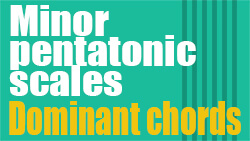 The minor pentatonic scale is by far the most used scale in the world all styles taken together (jazz, blues, rock, reggae, pop, country).
The minor pentatonic scale is by far the most used scale in the world all styles taken together (jazz, blues, rock, reggae, pop, country).One of the explanation is given by the structure. Indeed, there are no semi-tones in it. It is easy to play on the guitar and it can be used in a whole lot of very different contexts.
This lesson will show you eight ways to use the minor pentatonic scale over a dominant seventh chord. The principle is easy to understand, this consists in playing the minor pentatonic scale starting on each tone of the Mixolydian scale (1, 2, 3, 4, 5, 6, b7).
This method helps to highlight certain notes and brings interesting colors to your jazz guitar lines depending on you want to play outside or inside.
-
Triad Arpeggios - Guitar Lesson For Beginners
- By jazz-guitar-licks
- On 2017-08-25
- 2 comments
Arpeggios are surely the most important tools to master when you want to start improvising. They create a more harmonized sound when played with their corresponding chord. They are very helpful to easily outline the chord changes in solos and improvisations. This guitar lesson focuses on the most basic forms of arpeggios made out of three notes called "triad arpeggios".
-
The Tritone Substitution - Guitar Lesson With Theory and Tabs
- By jazz-guitar-licks
- On 2017-04-13
- 2 comments
The tritone substitution sometimes referred to as dominant chord substitution is one of the most popular harmonic technique found in jazz and other styles of music.
It involves replacing a dominant seventh chord with another dominant seventh chord located a tritone (or augmented fourth) away from the original chord's root.
-
What's a Half-Diminished Chord (m7b5)
- By jazz-guitar-licks
- On 2017-04-07
- 2 comments
This guitar lesson explains what is m7b5 chord, how to play it on guitar and how to apply it in common harmonic contexts as major and minor II-V-I progressions.
-
List of Musical Intervals - Music Theory
- By jazz-guitar-licks
- On 2017-04-06
- In Music Theory
- 2 comments
What is an Interval ?
An interval is the distance between two notes, each one is represented by a number (1,2,3,4,5,6,7...) and a prefix related to its quality ("M" for major, m for minor, "P" for perfect, "d" for diminished and "A" for augmented). There are five different qualities.
An interval can be melodic, when the tones are successive (played one after the other) and harmonic, if the notes are stacked (played simultaneously). Knowing the name of each interval on guitar and on any other instrument is very important.
Intervals are essential elements of music theory. Intervals are very useful to understand how chords and scales are built. This article shows you how to make the difference between them.
-
Chords in Fourths - Quartal Harmony
- By jazz-guitar-licks
- On 2017-01-07
- 2 comments
To enrich and modernize the harmonization of a piece it is common to use fourth chords.
They can replace some original chords to bring more melodic freedom into improvisation and more tension in harmony.
Since the late 1950s, harmony in fourths has played a very important role in the development of modern jazz.
Musicians and composers have used a lot quartal harmony.
Among them, the great American pianist McCoy Tyner, who, is a master in the art of playing quartal chords. Mike Stern, Herbie Hancock, Chick Corea, Bill Evans and Kurt Rosewinkel have also used this technique.
In this lesson with tabs and shapes, we will see how to build chords in fourths, how to harmonize the major scale with and how to use them in comping.
-
What's the Major 2 5 1 Progression - Guitar Lesson with Shapes , Tabs and Licks
- By jazz-guitar-licks
- On 2016-12-22
- 0 comments
The major 2 5 1 sequence is the most common chord progression used in jazz music but also in a whole number of styles of music as pop, rock, blues, country.
It is present in many jazz standards (Summertime, Autumn leaves, Blue bossa, All the things you are and many more), this is why it is very important to master it.
-
Harmonization Of The Major Scale - Guitar Lesson With Shapes and Charts
- By jazz-guitar-licks
- On 2016-12-19
- 2 comments
Scale harmonization is the process of creating chords from each note of a given musical scale. This is one of the fundamental theoretical elements to understand music.
This lesson explains how to create triads and seventh chords from each note of the major scale.
-
What Are Guide Tones and How to Use Them
- By jazz-guitar-licks
- On 2016-12-14
- 2 comments
Guide tones are the notes in a chord which leads or gives harmonic pull toward the next chord, these are an excellent way to study and absorb the sound of any chord progression.
Guide tones are used to outline chord progressions in an improvisation.
They are most of the time the 3rd and the 7th because this is what determines whether a chord is major, minor, or dominant.
This jazz guitar lesson explains how to solo over common jazz chord progressions by using guide tones.
-
What Are Drop 2 Voicings - How To Play Them On Guitar
- By jazz-guitar-licks
- On 2016-12-09
- 0 comments
Drop 2 chords are very used and appreciated by guitarists of all styles, they are formed by dropping the second highest note of a four-note chord in close position down an octave.
This guitar theory lesson with diagrams and charts explains how drop 2 chords are built and how to play them.
-
Guitar Modes And Scales For Beginners
- By jazz-guitar-licks
- On 2016-07-12
- 0 comments
Ecclesiastical modes, also named "Greek modes"or "church modes" or "Gregorian modes" formed in the Middle Ages a set of seven scales whose use has weakened because of the appearance of the major / minor tonal system.
Several centuries later these modes have reappeared. They are very used in jazz improvisation as scales of chords and modal playing.
This guitar lesson explains what are the seven modes, how they are built and how to play them on guitar.
